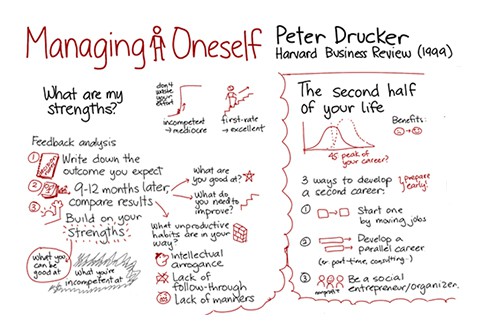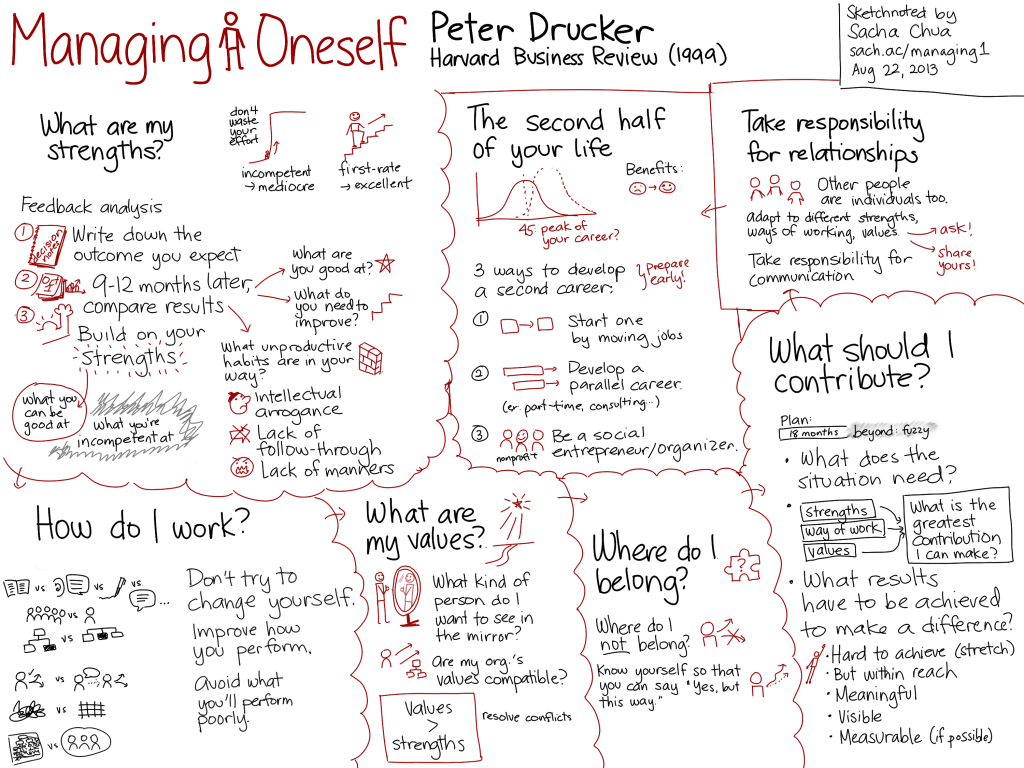A New Spin on a Drucker Favorite

Todd Hitchcock
Every year I re-read Peter Drucker’s Harvard Business Review article ‘Managing Oneself‘. I use it to make sure I am on track and mindful of my own performance and what I can do better. There have been 100’s (maybe (1000’s) of summaries and reviews of ‘Managing Oneself’ but thought I would share a different perspective. Before I do that though, for those of you who have not read the paper (and you really should), here is a brief summary:
Drucker uses five framing questions:
1. What are my strengths?
To determine these strengths, when you are making key decisions, it is important to write down how you will solve the problem (your approach(es)) as well as what you think will happen. Then, go to work. 18 months later +/- go back and review these as compared to what you did and what worked (and what did not). In essence, you are creating a personal feedback loop (maybe it was learning to program in CP/M and BASIC but I am a big believer in feedback loops).
Personally, I have found that for this to be effective, you need to do this for multiple initiatives and be consistent, so patterns emerge.
Once this is complete, identify both the things that were productive and those that were not. Now, this is the big one – do just enough to get the areas where you have low levels of competence up to par and drill it on developing your strengths.
“It takes more energy to improve from incompetence to mediocrity that to improve from first-rate performance to excellent”
2. How do I work?
Once you have identified your strengths, it is important you work to identify how you learn and work best (you can also work on this in a parallel process). This can include determining whether you consume information by reading, listening, watching, doing, etc.
It is also important to learn what environment you work best in and the engagement model of the people you work best with (i.e. do you perform best in groups or as an individual, do you work best in open spaces or more closed off ones, do you perform best in situations that are predictable or nebulous, etc). What I have learned over the years about myself is that for me personally, there is a mix – but I know exactly what the mix is and when it works for me.
3. What are my values?
This one should be the easiest – but I realize for many it is sometimes not. The questions to ask yourself are: does your organization’s ethics align to your own values and are you working on work that is valuable to society? If not, run like hell until you find a place where you can answer yes to these questions (ok, that is me talking now, not Drucker).
I am fortunate to work in an organization whose values align to mine. Our core values revolve around being brave, imaginative, and decent . Social purpose means something.
4. Where do I belong?
This one takes some time to assess and decide on. You need to try enough different things (and this can mean moving around a bit) to allow you to apply your strengths, your work styles, and your values to in sure the right fit. You need to be mindful of this one and not let dogma set in. Keep searching until you find what is right and you will be ‘transformed from an employee to a star performer’.
5. What can I contribute?
When many people read this one for the first time, they think of making a grand contribution that will leave a legacy. Drucker does a great job of breaking this down to focus on making a contribution in the present moment. He asks three key questions:
1. What does the situation require?
2. Given my strengths, my way of performing and my values, how can I make the greatest contribution to what needs to be done?
3. What results have to be achieved to make a difference? Breaking this down is key, as these questions can be applied over and over – in a job, on a project, or in an individual situation. These are great questions to prioritize and focus your efforts.
Sacha Chua graciously agreed to allow me to post her doodle summary of ‘Managing Oneself’ in my blog. This is an excellent visual representation of the paper:

THE NEW SPIN
After recently re-reading this and starting my annual process, I started to see ‘Managing Oneself‘ through an entirely different lens. Two lenses actually:
Leadership and Others
1. What if we take these same framing questions and applied them to leading others?
2. What if we only focused on developing peoples’ strengths (people on our teams) and just getting them the bare minimum of what they need in areas they are not strong in (I know many great leaders who do this now)?
3. What if we created work environments to move people around – into different mini roles, set them up in different work environments, had them communicate in different ways, etc – and created feedback loops on what was working and what was not?
4. What if we created (and put into practice) multi-variant feedback loops for individuals based on the pre-identified variables noted above?
5. What if…
The idea hear is, what if we expanded these same principles that have worked for so many of us as individuals into a set of tools / a framework for leaders to develop others?
Assessment in Education
‘Personalization’ is the red-hot word in education right now – as it should be. There are many great things happening in instructional models (Competency Based Education), data & analytics, online, blended, and more. But…
1. What if we were to create a framework for personalization that transcended all of these areas?
2. What if we were to be less focused on ‘averages’ and scores across all areas and focus more on how learners are achieving in their areas of strength?
3. What if we created learning environments that celebrated ‘failure’ (I like to think of everything as ‘experimentation’) to allow learners to utilize feedback loops to learn, iterate, evolve (and not be penalized with grades)?
4. What if we customize the learning environments and instructional models based on individual’s learning styles (i.e. what if we were to determine how each student learns best, and then correlate it with specific instructors / programs that utilize those models)?
5. What if…
There are great leaders, educators, and schools out there practicing some of these principles. My question is, is Drucker’s framework extensible beyond managing oneself and could it be as wildly successful if applied to ‘others’?
Tweet your thoughts to: @toddahitchcock
This blog first ran on toddhitchcock.com.

Todd Hitchcock is Senior Vice President, Online Solutions & Business Development Pearson.






Laura
Your proposition in #3, to celebrate failure, is something that I struggle with constantly with my students. They want to be experts from day one of a unit, they don't want to go back and edit or go back and change...they think the first time they write or respond or read they should be perfect. I realize that this is supported in society and in many of our testing situations, but I think that the growth mindset and grit truly play to helping students be open to learning and growing. Earlier this year, I had a student who thought they had found something I said to be incorrect. Their response was to send me a Wikipedia article and email with "HAHA, YOU'RE WRONG." This kind of thinking is only a more outward expression of what many students hear from teachers or other students. My response to him, was that's ok, you were wrong too, let's look again together. He was taken aback at the idea of reworking thinking and accepting failure. Here's to continual learning.